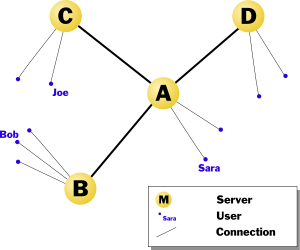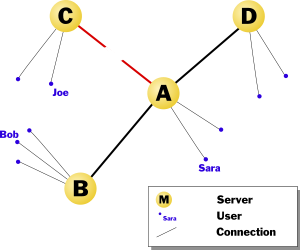- Netsplit
-
In computer networking, specifically Internet Relay Chat (IRC), netsplit is the disconnection of a given node from the previously established network or between two nodes. As an IRC network is an undirected acyclic graph, a split between any two nodes splits the entire network into two pieces.
Consider the graphic to the right, which represents the computer network. Each line represents an established connection between the two nodes; each node represents either a server or a user on the network. Therefore, the server C is connected directly to A, which is also connected to B and D.
If a disruption in the connection between C and A occurs, the connection may in result be terminated. This can occur either by a socket producing an error, or by excessive lag in which the far server A anticipates this case (which is called a timeout).
When the connection between A and C is severed, users that were connected to other servers which are no longer reachable on the network appear to quit. For example, if user Sara is connected to server A, user Bob is connected to server B, and user Joe is connected to C, and C splits, or disconnects, from A, it will appear to Joe as if Sara and Bob both quit (disconnected from the network), and it will appear to both Sara and Bob that Joe quit. However, Joe can still talk to anyone on the same server C. This happens because the servers in which they are connected are informed of the change in the network status, and update their local information accordingly to display the change.
Later, server C may relink (reconnect) to a server on the network and the users who appeared to have quit will rejoin; the process of sending this updated information to all servers on the network is called a netburst (or sync).
Occasionally, users will attempt to use netsplits to gain access to private channels. If none of the channel users were on server C, a user could join a private channel and later gain access when the servers relink. This is commonly known as split riding or riding the split.
Another typical netsplit-oriented IRC attack is Nickname Colliding. In this attack, a user on a split segment of the network would change nicknames to that of a user on the other side of the split network. Upon reconnection, the network would disconnect both users because only one nickname may be in use at one time. Modern IRC server software has largely eliminated this method, but servers using older software may still be vulnerable.
Contents
Appearance of netsplits
Below is an example of typical netsplit. When two servers split, a user sees this as large number of users quitting. After the servers are reconnected, a user sees the other users rejoining.
On GUI IRC clients
* usera has quit (a.irc.net b.irc.net) * userb has quit (a.irc.net b.irc.net) * userc has quit (a.irc.net b.irc.net) * usera has joined #channel * userb has joined #channel * userc has joined #channel
On command-line client irssi
00:00 -!- Netsplit a.irc.net <-> b.irc.net quits: usera, userb, userc 00:00 -!- Netsplit over, joins: usera, userb, userc
To a user on a private network
* usera has quit (*.net *.split) * userb has quit (*.net *.split) * userc has quit (*.net *.split) * usera has joined #channel * userb has joined #channel * userc has joined #channel
References
- Hossein Bidgoli: The Internet Encyclopedia- Volume 2. Wiley 2004, ISBN 9780471222040, p. 312-313
External links
- Netsplit Manual (retrieved 2009-12-2)
Internet Relay Chat (IRC) General topics Common terms Lists and comparisons Related protocols See also Clients (comparison) Mac OS X Microsoft Windows MS-DOS Unix-like Cross-platform Cross-platform (Java) Multi-IM Multi-IM (Java) Web-based Web browser components Library and plug-ins Bots (comparison) Bouncers, Gateways and Proxies Daemons Networks Categories:- Internet Relay Chat
- Computer errors
Wikimedia Foundation. 2010.



